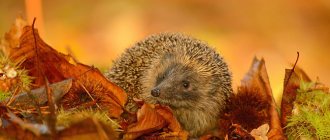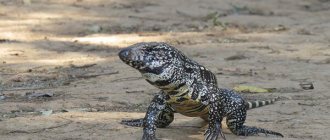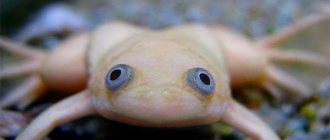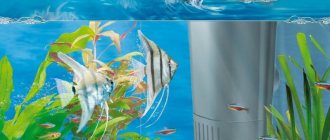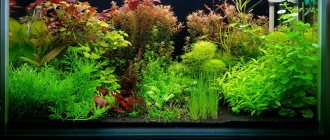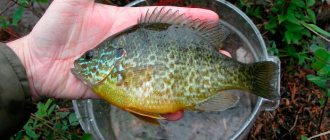5
(13)
In the world of aquariums, there is literally a whole army of fans of the cichlid family. Not surprising, because these are truly amazing animals, significantly different from other representatives of the underwater fauna in their color, habits and other features.
The most popular fish are Malawian cichlids. In terms of relevance, only astronotuses and parrots can compete with them. This demand is explained by the fact that these animals are not particularly whimsical, and thanks to their incredibly beautiful color they are able to decorate any aquarium.
Homeland of Malawian cichlids
In nature, these fish live only in the African Lake Malawi, where their distant ancestors came from neighboring Tanganyika. Over thousands of years, about five hundred new species have formed here, each of which has its own characteristics of appearance and behavior. The evolution continues to this day. Lake Malawi is deep with clear water and varied bottom topography. That is why new species are formed here so easily. Fish adapt to different conditions, acquire new colors and ways of protecting themselves from enemies. One thing remains in common: these fish carry fertilized eggs in their mouths. At first, the fry also hide in their parents’ mouths at the slightest threat. These are the conditions of survival in Malawi.
Some species of cichlids are of commercial importance to humans, while others are decorative and thrive in home and office aquariums.
Behavioral characteristics of the family Cichlidae
The behavior of these representatives of the underwater fauna is peculiar and attractive. Sociable and active by nature, cichlids are in constant motion, using the entire space of the aquarium.
Their activity increases in proportion to the increase in hunger. In pursuit of a portion of food, they organize real races and can instantly absorb everything that is offered to them, although such greed does not bring them any benefit.
Certain types of fish have highly developed hunting skills:
- nimbochromis, buried in the sand, pretend to be inanimate, thereby luring prey;
- Copadichromis, having a tube-shaped mouth, is able to easily suck in plankton like a vacuum pump.
The intelligence of cichlids is attractive to aquarists. They are able to recognize their owner and demonstrate unique social behavior.
Articles about cichlid fish on AquariumGuide.ru:
See the rules for caring for Managuan cichlasoma here.
With whom can you keep Cichlasama salvini fish?
Thus, almost all varieties of this family have developed parental care for their offspring. Cichlid aquarium fish carefully guard their clutches and care for the larvae and fry. Specifically, the Malawian species of fish hatch eggs in their mouths, and the hatched fry find refuge in the throat sac of their parents in a moment of danger. Therefore, with a relatively small number of eggs in these fish, their survival rate is quite high.
Description
Despite such wide species diversity, all cichlids have a number of common features. They have an oblong body along which the upper fin stretches, a large head with full lips, and hard anterior rays on the fins. All cichlids have bright colors, especially during the breeding season. The cichlid is a predator, a fish with character, it protects its territory and is constantly busy with something. It is for their character that aquarists love them so much.
Varieties contained in Russia
Of the hundreds of cichlids that live in Lake Malawi, our aquarists breed only a few dozen. Next are the most beautiful and popular Malawian cichlids in Russia.
Common aquarium cichlid species from Lake Malawi:
- Aulonocara. The second name for these fish is “peacock cichlids.” In males, as they grow older, the coloration transforms from modest to bright, variegated colors. There are yellow, red, blue, gold, light blue and other colors. Body length - 8-20 cm. Aquarium volume - from 100 liters.
- Blue dolphin. It is bright blue in color and has a fatty lump on its head that makes the fish look like a dolphin. Length - up to 25 cm. Aquarium volume - from 250 liters.
- Pseudotropheus. This is a whole group of cichlids with interesting behavior and varied colors. There are red, yellow, blue, striped and other fish. Length - 9-12 cm. Aquarium volume - from 150 liters.
- Melanochromis. One of the most aggressive Malawian cichlids. The color is yellow or blue, there are longitudinal stripes. Body length - 11 cm. Territoriality is developed. Aquarium volume - from 200 liters.
- Labidochromis. The most common species is Labidochromis Yellow. The fish has a rich yellow color and dark edging on its fins. They are relatively peaceful and can get along with many medium-sized fish. Body length - up to 10 cm. Aquarium volume - from 100 liters.
- Bumblebee cichlid. Other names: pseudotropheus crabro, chameleon cichlid. The color is yellow-black, like a wasp or bumblebee. Has interesting behavior. Aquarium volume - from 180 liters.
- Golden cichlid. Scientific name: Melanochromis auratus, Very aggressive. Even keeping the sexes together is not recommended. The color is golden, with wide horizontal stripes. Aquarium volume - from 200 liters.
- Zebra mbuna. Scientific name: Pseudotropheus zebra. They have an elongated body, compressed at the sides. Length - up to 15 cm. Color is different, more than 50 options - blue, orange, black and white, bluish-black. Aquarium volume - from 150 liters.
- Red cadango. A relatively peaceful cichlid, it shows aggression only during the spawning period. The body is red, the head is blue, and the fins have a white border. Body length - 15 cm. Aquarium volume - from 300 liters.
- Dimidochromis. This is one of the most colorful predators, with blue and orange shades dominating the coloration. Able to quickly take off from a place, has powerful jaws.
Despite its predatory nature, it is peaceful towards cichlids of similar size and is popular in biotope aquariums. Length - 25 cm. Aquarium volume - from 450 l.
Groups of cichlids
African cichlids are usually divided into two large groups - “utaka” and “mbuna”.
Fish from the “mbuna” group (from the Malawian language - “attacking rocks”) are somewhat more peaceful than the “utaka”; in the wild they reach 15 cm in length. They feed mainly on plant matter, scraping algae from rocks. In the aquarium they love to dig in the soil, dig up plants, and rearrange stones that they can lift at their discretion. In a word, these are real interior designers. They settle in thickets of grass, finding convenient shelters there. The most common species from this group are tropheus, pseudotropheus, labidochromis, laboeotropheus, melanochromis.
"Utaka", in turn, are distinguished by their aggressiveness. They are not averse to eating plankton and small fish. These cichlids are larger (can reach 25 cm); they choose shallow water with plenty of shelters for their habitat. In a cramped aquarium, there can be fierce battles for space, so cichlids from this group must be kept in large volumes and fed with live food. “Utaka” include Alunocar, Docymodus, Haplochromis and others.
Aquarium lighting
Make sure you have fluorescent lighting. Fluorescent lights provide the correct spectrum for healthy fish growth. They produce less heat than incandescent bulbs, which can potentially heat water to dangerous levels.
Another great benefit is that they bring out the natural color of your fish. But keep in mind that if the lighting is too bright, the colors of the fish may be washed out, and the cichlids themselves will be nervous and irritable. White lighting would be an excellent option.
Content
Before you get cichlids, be sure to set up an aquarium. The soil should be of medium size - not sand or large stones. Snow-white quartz is often used in cichlid fish; it not only matches the characteristics, but also has an elegant appearance. Cichlids always need shelters and burrows, space to swim and privacy. To create a biotope similar to the bottom of Lake Malawi, piles of sandstone, grottoes, pots, and ceramic tunnels are often used.
The volume of the aquarium for most species of cichlids starts from 100 liters (usually even from 150 liters). This is a very important parameter, since in a small aquarium, if there is overpopulation, the fish will not grow, will not acquire all the beautiful colors and will ultimately fight over the territory, leaving the most aggressive and strong ones. If you have only one adult cichlid left, you will not be able to add fry to it, even if they are of the same breed. She will eat them, preserving the peace of her space.
Various biotopes of Lake Tanganyika
By examining different biotopes in the lake, we can understand how cichlids mastered this or that niche.
So:
Surf zone
Just a few meters from the shore can be considered the surf zone. Constant waves and currents create water here with a very high oxygen content, since carbon dioxide disappears instantly.
The so-called Gobi cichlids (Eretmodus cyanostictus, Spathodus erythrodon, Tanganicodus irsacae, Spathodus marlieri) or bull cichlids have adapted to life in the surf line, and this is the only place in Tanganyika where they can be found.
Rocky bottom
Rocky places can be of various types, from fist-sized stones to huge boulders several meters in size. In such places there is usually a very steep coast and the stones lie on other stones, not on the sand.
As a rule, sand washes onto stones and remains in crevices. Many cichlids dig nests in such crevices during spawning.
The lack of plants is compensated by the abundance of algae, which cover the stones and serve as food for many species of cichlids; in fact, fish that live mainly on fouling and feed.
This biotope is rich in fish with different behavior and habits. Both territorial and migratory species live here, cichlids living alone and in flocks, those that build a nest and those that carry eggs in their mouths.
The most widespread species are cichlids that feed on algae growing on rocks, but there are also plankton and predatory species.
Sandy bottom
Soil erosion and wind create a thin layer of sand at the bottom in some areas of Lake Tanganyika. As a rule, these are places with a relatively sloping bottom, where sand is carried by the wind or with rainwater.
In addition, in such places the bottom is abundantly covered with shells from dead snails. This is facilitated by the nature of the bottom and the parameters of the water, in which the disintegration of shells occurs rather slowly. In some areas of the bottom they form a continuous carpet. Many species of cichlids living in these places have adapted to live and spawn in these shells.
Typically, cichlids living in sandy biotopes are gregarious. After all, the best way to survive for fish that live in open places and are not large in size is to form a school.
Callochromis and Xenotilapia live in schools of hundreds of individuals and develop a strong hierarchy. Some, when in danger, immediately bury themselves in the sand. However, the body shape and coloring of these cichlids is so perfect that it is almost impossible to see them from above.
Muddy bottom
Something between a rocky and sandy bottom. Places where rotting algae residues accumulate and soil particles wash from the surface. As a rule, these are places where rivers and streams flow into the lake.
Silt serves as a food source for a variety of bacteria, and those, in turn, for various bioplankton. Although some of the plankton is eaten by cichlids, the bulk is eaten by various invertebrates, which also serve as food for the cichlids.
In general, places with muddy bottoms are atypical for Tanganyika, but they do occur and are distinguished by a variety of life.
Pelagic layer
The pelagic layer is actually the middle and upper layers of water. It is precisely these layers that account for the bulk of the water in Tanganyika; according to rough estimates, from 2.8 to 4 million tons of fish live in them.
The food chain here begins with phytoplankton, which serves as food for zooplankton, which in turn feeds fish. Most of the zooplankton is eaten by giant schools of small fish (not cichlids), which serve as food for predatory cichlids living in open water.
From the editor: Ampularia
Benthos
The deepest, bottom and near-bottom layers in the lake. Considering the depth of Tanganyika, not a single river fish can survive in these places, since there is very little oxygen there. However, nature does not tolerate a vacuum and some cichlids have adapted to life in conditions of oxygen starvation and complete darkness.
Like bottom-dwelling sea fish, they have developed additional sensory organs and a very limited way of feeding.
An hour of underwater filming in the lake. No comments, just music
Caring for Cichlids
Malawians are fairly easy to care for. It is only important to systematically perform certain duties.
- Weekly water changes. The volume is about a quarter of an aquarium.
- Regular soil cleaning. To clean the soil, you can use a special aquarium siphon and combine this process with water changes.
- Maintaining the required water parameters. Temperature 24-28°C, hardness from 6 to 10, pH (acidity) 7.5-8.5. In principle, the water parameters for keeping cichlids are average, and it is usually not difficult to maintain them.
- Filtration.
- Constant aeration.
- Correct dosage of feed.
How long do cichlids live in captivity? With proper care, the life expectancy of Malawian cichlids is 5-8 years. The diseases that cichlids are susceptible to are the usual list of fungal infections, outbreaks of which occur due to improper husbandry. If you have provided the fish with good care, they should not get sick.
Disease Prevention
Experienced aquarists claim that more than 90% of cichlid diseases described in the literature do not occur in practice. Although an important role in maintaining the health of pets is played by the desire to create ideal conditions for them. Therefore, an indispensable approach to maintaining any type is the following:
Prevention of fish diseases is the creation and maintenance of conditions that are vital for a given species. You should not allow even one fish to remain in a prolonged state of stress, as this is the first stage of illness or weakening of the immunity of all inhabitants of the aquarium.
You need to carefully monitor the condition of your pets and promptly place them in a separate “house” if necessary. This way you will save others.
Feeding
Feeding a cichlid is also easy. You can give special dry food for cichlids, which contains substances to maintain color. Malawian cichlids, as already mentioned, are not averse to eating live food (just make sure that the food fits into the fish’s mouth, otherwise it may choke without calculating its strength). Even mbuna, which in nature feed mainly on plant food, will happily start eating bloodworms in an aquarium. Good nutrition is the key to proper development, rapid growth of fish and their ability to reproduce. The number of feedings per day is 2-3 for fry, adults can be fed once. Make sure that the fish eat all the food within 5-7 minutes. If they eat it, reduce the portion.
Reviews
Aquarists recognize that Malawian cichlids are one of the most interesting and colorful fish. But there are plenty of problems with them - if you don’t delve into the peculiarities of their behavior.
Evgeniy R., aquarist with 5 years of experience. At the dawn of my hobby, I introduced the cichlids that were given to me into a community aquarium. They were completely harmless in appearance. It was difficult to think that they were capable of the bloodthirstiness demonstrated later. First, the cichlids attacked the goldfish and guppies. Then they began to grow rapidly and needed a huge aquarium. It is advisable for beginners to learn about this in advance.
Liliya Sh., amateur aquarist. The Malawian cichlid is smart, beautiful, but does not tolerate other fish at all. My favorite cichlid, once in the aquarium, first ate the neons, then its “friend,” and then the catfish. Since then I have kept these aggressors only in a species aquarium.
Malawian cichlids are colorful and interesting fish that will bring a lot of energy and aggression to any aquarium. These active and beautiful fish will be extremely interesting to watch for both beginners and experienced aquarists.
Compatibility and Behavior
The main rule of compatibility is that it is best to place only cichlids in an aquarium with cichlids. Anything peaceful that fits into a fish’s mouth will sooner or later be eaten. Therefore, combine types that will later be approximately the same in size. Interspecific compatibility is best checked for specific species. Large catfish, pterygoplichths and ancistrus, also coexist in the same room with Malawian cichlids.
If you follow these recommendations, your aquarium and its inhabitants will enjoy beauty and health for a long time! And remember: Malawian cichlids are not difficult at all!
Reproduction
All popular types of decorative cichlids reproduce easily in an aquarium. When favorable conditions are created, spontaneous spawning can occur, during which even the most peace-loving fish become aggressive, protecting their offspring.
05:14
Breeding cichlids in aquariums, tips and tricks.
Malawians lay eggs on any flat surface, be it a stone, a plant leaf or the glass of an aquarium. The female takes the fertilized eggs into her mouth, where she carries them for several weeks until they grow into full-fledged fry. To reduce the load on the female so that she can quickly produce new offspring, eggs can be grown in special incubators. However, there is a risk that during the collection of eggs, the female will swallow it!
Cannibalism often occurs among fry, so it is better not to allow fish of different sizes to be adjacent to each other, even within the same litter.


